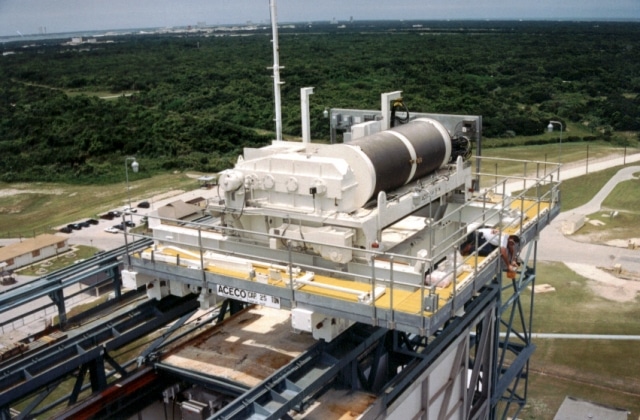Aerospace manufacturers regularly lift, turn, and position large components when assembling their products. These lifts are deemed critical since the items being hoisted are usually cumbersome, sensitive to damage, and extremely expensive. The margin for error in these applications is slim, and any mistakes can result in significant production delays.
With so much at stake, aerospace cranes tasked with lifting must be carefully selected and specially designed to meet the stringent standards of the industry. In recent years, American Crane has proudly supplied several prominent companies in the industry with lasting solutions to these difficulties.
How NASA Used a Double Girder Crane
 Lockheed Martin contracted American Crane to design an assembly crane for The National Aeronautics and Space Administration (NASA) Orion, its first spacecraft designed for long-term manned space flight and exploration. NASA faced the challenge of lifting the vessel’s spacecraft crew module to its final position atop the service module.
Lockheed Martin contracted American Crane to design an assembly crane for The National Aeronautics and Space Administration (NASA) Orion, its first spacecraft designed for long-term manned space flight and exploration. NASA faced the challenge of lifting the vessel’s spacecraft crew module to its final position atop the service module.
To successfully lift and install the crew module, NASA needed a crane suited to the job. Since the Orion capsule weighs 22,899 pounds (about 11.45 tons), its crane needed enough capacity to handle to the weight of the module, with additional capacity as a safety margin.
Mounting aerospace components is a delicate process that requires highly accurate equipment. NASA’s crane needed to accommodate precise movements to ensure the proper alignment of the separate components during installation. In addition, sensitive handling was required to minimize the possibility of damage due to improper handling or falling debris.
With NASA’s specifications in mind, American Crane designed a top-running double girder crane with a 25-ton capacity, more than twice the weight of the capsule. To provide NASA with greater control over movement during assembly, the crane also featured micro speed movements.
Our crane included specific ‘clean room’ features such as self-locking stainless steel fasteners to prevent the loosening of bolts, walkways equipped with kick plates to capture falling debris, and runway conductor bars enclosed in a plastic housing. Special coatings were applied to prevent corrosion.
NASA successfully uses the double girder crane to lift the Orion module to its final position. Permanently installed at the Kennedy Space Center, the double girder crane continues to be used for other sensitive hoisting applications such as telescope arrangement, lens management, and spacecraft maintenance.
Other Cranes for Aerospace Industry
Double girder cranes are just one of the many types of cranes used in the aerospace industry. Facility size, maximum lifting weights, and clearance heights are some of the factors that need to be taken into consideration when searching for an aerospace crane.
In another example of our work, Boeing hired American Crane to produce a material handling system for its manufacturing plant in North Charleston, SC, where it constructs the 787 Dreamliner. The system needed to be able to access all areas of the 460,000 square foot facility while allowing users to intricately and precisely lift any component.
For this particular application, we created an 80-ton underhung crane consisting of multiple bridges. To promote access to the entire facility, the crane was designed without columns so that the bridges could be interlocked, allowing the trolley to cross from one bridge to the other. Its precision control design further enables Boeing to safely lift objects with difficult centers of gravity regardless of their size.
For more than four decades, American Crane has proudly worked with Lockheed Martin, Boeing, and other authorities in the aerospace industry to solve their manufacturing challenges. Specializing in start-to-finish design and fabrication, we’re pleased to be recognized as the leading provider of crane and hoist solutions in the industry.
To learn more about the various types of overhead cranes used in the aerospace industry, download our eBook, Building Toward the Sky: Overhead Cranes for Aerospace.


